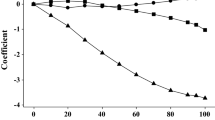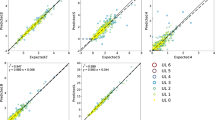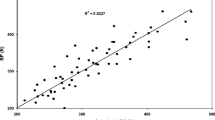Abstract
Partition coefficients for varied compounds were determined for the ethylene glycol–organic solvent biphasic partition system where the organic solvent is n-heptane, 1,2-dichloroethane or isopentyl ether. These partition coefficient databases are analyzed using the solvation parameter model facilitating a quantitative comparison of the ethylene glycol-based partition systems with other totally organic partition systems. Ethylene glycol is a cohesive solvent, reasonably dipolar/polarizable, strongly hydrogen-bond basic, and moderately hydrogen-bond acidic. Ethylene glycol–organic solvent systems offer a complementary approach to other totally organic biphasic partition systems for sample preparation and descriptor measurements of compounds virtually insoluble in water.


Similar content being viewed by others
References
Sarafraz-Yazdi A, Amiri A (2010) Trends Anal Chem 29:1–14
Jeannot MA, Przyjazny A, Kobosa JM (2010) J Chromatogr A 1217:2326–2336
Rezaee M, Yamini Y, Faraji M (2010) J Chromatogr A 1217:2342–2357
Poole SK, Dean TA, Oudsema JW, Poole CF (1990) Anal Chim Acta 236:3–42
Poole CF (2003) Trends Anal Chem 22:362–373
Berthod A, Carda-Broch S (2004) J Chromatogr A 1037:3–14
Abraham MH, Ibrahim A, Zissimos AM (2004) J Chromatogr A 1037:29–37
Karunasekara T, Poole CF (2010) J Sep Sci 33:1167–1173
Karunasekara T, Poole CF (2011) Talanta 83:1118–1125
Karunasekara T, Poole CF (2011) J Chromatogr A 1218:809–816
Poole CF, Atapattu SN, Poole SK, Bell AK (2009) Anal Chim Acta 652:32–53
Abraham MH, Poole CF, Poole SK (1999) J Chromatogr A 842:79–114
Poole CF, Poole SK (2002) J Chromatogr A 965:263–299
Poole CF, Gunatilleka AD, Poole SK (2000) Adv Chromatogr 40:159–230
Abraham MH, Gola GMR, Kumarsingh R, Cosmetto-Muniz JE, Cain WS (2000) J Chromatogr B 745:103–115
Ahmed H, Poole CF, Kozerski GE (2007) J Chromatogr A 1169:179–192
Atapattu SN, Poole CF (2009) J Chromatogr A 1216:7882–7888
Forkner MW, Robson JH, Snellings WM, Martin AE, Murphy FH, Pearsons TE (2004) In: Kirk-Othmer Encyclopedia of Chemical Technology, vol 12. Wiley, New York, pp 644–682
Paterson A, Couradi RA, Hilgers AR, Vidmar TJ, Burton PS (1994) Quant Struc Act Relat 13:4–10
Abraham MH, Martins F, Mitchell RC, Salter CJ (1999) J Pharm Sci 88:241–247
Abraham MH, Acree WE (2010) New J Chem 34:2298–2305
Kazoka H, Shatz V (1996) J Chromatogr A 732:231–238
Silber JJ, Falcone RD, Cores NM, Biasutti MA, Abuin E, Lissi E, Campodonico P (2003) Langmuir 19:2067–2071
Kennard RW, Stone LA (1969) Technometrics 11:137–148
Ahmed H, Poole CF (2006) J Chromatogr A 1104:82–90
Ahmed H, Poole CF (2006) J Sep Sci 29:2158–2165
Qian J, Poole CF (2007) J Chromatogr A 1143:276–283
Author information
Authors and Affiliations
Corresponding author
Rights and permissions
About this article
Cite this article
Karunasekara, T., Poole, C.F. Models for Liquid–Liquid Partition in the System Ethylene Glycol–Organic Solvent and Their Use for Estimating Descriptors for Organic Compounds. Chromatographia 73, 941–951 (2011). https://doi.org/10.1007/s10337-011-1996-4
Received:
Revised:
Accepted:
Published:
Issue Date:
DOI: https://doi.org/10.1007/s10337-011-1996-4




